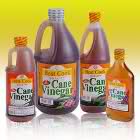 Vinegar has earned its niche in any Filipino kitchen. Almost all mouth-watering dishes need a teaspoonful or two of vinegar. It is even an ingredient for some cakes, souffles’ and native delicacies. It is not surprising that the simple vinegar has assumed a variety of forms in seasonings, dressings, marinades, sauces and gravies. Vinegars with suitable oils, herbs and spices are a chef’s well-kept secret to a gourmet feast. Moreover, vinegar can be more than an addition to any dish–it can be a source of income—a promising business venture for any Filipino who is interested in making more money at home.
Vinegar has earned its niche in any Filipino kitchen. Almost all mouth-watering dishes need a teaspoonful or two of vinegar. It is even an ingredient for some cakes, souffles’ and native delicacies. It is not surprising that the simple vinegar has assumed a variety of forms in seasonings, dressings, marinades, sauces and gravies. Vinegars with suitable oils, herbs and spices are a chef’s well-kept secret to a gourmet feast. Moreover, vinegar can be more than an addition to any dish–it can be a source of income—a promising business venture for any Filipino who is interested in making more money at home.
The Sugar Regulatory Administration (SRA) has packaged a fast, easy-to-follow and cost effective technology on making vinegar. This technology produces naturally fermented sugarcane vinegar from sugarcane juice in just two weeks.
Materials
Making vinegar provides an avenue for utilizing over-riped fruits, sugarcane rejects, ethyl alcohol rejects and cane by-products such as molasses, bagasse and tops.
In the Visayas, southern Tagalog areas and Central Luzon, the most common materials used for vinegar making are nipa palm sap, coconut palm sap, pineapple juice and sugared coconut water. However, in sugar areas where leftover canes rejected by mills abound, it is recommended that these materials be utilized.
Young canes may also be used for vinegar making. If the juice extracted is below 15-16 degrees brix, small amounts of sugar are added. Molasses or muscovado can be used instead of sugar.
How to make vinegar
1. Remove trash and wash canes.
2. Crush sugarcane stalks to extract juice. To increase recovery, make two or three passes. Collect juice in earthen jars.
3. Bring filtered juice to a boil or cover the earthen jars (w/juice) to high temperature. One day under the sun is enough to destroy contaminants.
4. Add one-half gram (1/4 of fresh cake) of yeast per liter of juice. Reactivate yeast by hydration before addition. Stir very well. Use only wooden or bamboo spoons. Never use metallic spoons or containers.
5. Allow suspended soil particles and other extraneous materials to flow over for 2-3 days. Use narrow-mouthed jars during this period of fermentation.
6. You will observe that a clean amber-colored liquid will remain after suspended dirt is removed. Clean the jars’ mouths with a damp cloth. Cover jars with katsa or earthen jar cover. Air is not required at this stage of fermentation.
7. Let the liquid stand for another five days. Alcoholic fermentation is a fast process, it is almost complete after 3-4 days.
8. Test alcoholic fermentation with a hydrometer. If brix is zero, proceed to acetic acid fermentation, If you have no hydrometer, just take note of the movement of gases in the liquid. Once there are less gases produced, proceed to the next step.
9. Transfer or siphon the liquid to wide-mouthed earthen jars. Do not include the yeast sediments. Mix four parts of the liquid with one part of good unpasteurized vinegar (mother liquor).
10. Stir thoroughly. Cover with a clean piece of cloth. Repeat mixing at least twice a day. Use only wooden/bamboo ladles. Do not fill the jars up to the brim. Leave some air space. At this stage, oxygen is required by the fermenting organisms.
11. Allow the liquid to ferment until acidity is strong enough (4-6% acetic acid). In one to two weeks, the vinegar is ready for bottling. Test liquid for acetic acid content in the laboratory for quality control.
12. Siphon into bottles and pasteurize at 60-70 deg. C for 20 minutes, to arrest further fermentation. Label.
13. Retain 1/5 of the fermented vinegar in the wide-mouthed jars for the second batch.
14. Continue with the procedure a long as there are no contaminants. As soon as abnormal smell or growth of other organisms is observed, clean the jars very thoroughly and use another batch of mother liquor. If there are only a few contaminants, boil the fermented liquid and test it if it can be pasteurized and used as vinegar.
(Source: Vinegar production from canes, SRA Industrial Research and Development Office)
Article from Mary Charlotte O. Fresco – bar.gov.ph, July-September 2001 Volume 3 No. 3
Do you like this money making business ideas for entrepreneurs? then please consider subscribing to our RSS feed and have new business ideas sent directly to your inbox. (Once you entered your e-mail address, you need to login to your e-mail account and click the link to confirm your subscription).




Pwede po pa send sa email ko sa pag gawa ng suka or coco venigar pls…..
Meron po kau semenar for making coco venigar??
Saan puwede mag aral nito basic vinegar making at makabili ng mother liquir para sa nata de coco.
ask ko po kung saan ang seminar sa paggawa ng vinegar? thank you..